When it comes to soldering, there are a few different things you need to know in order to do it right. In this article, we will discuss the differences between flux and solder paste.
We will answer some common questions about each, and provide tips on how to use them correctly. So whether you’re a beginner or a seasoned pro, read on for all the information you need to make the best solder joints possible!
What is Solder Paste?
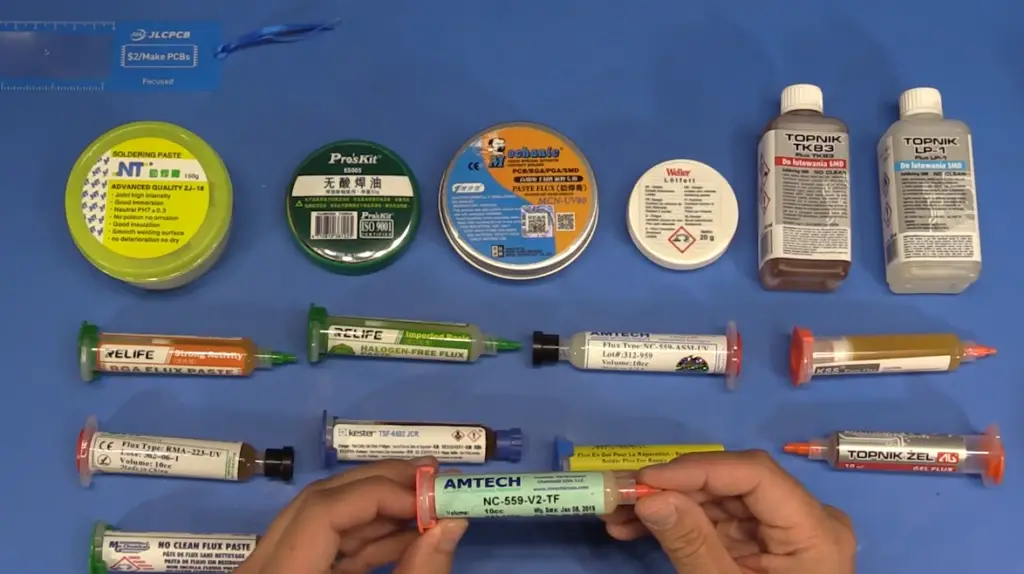
It is usually thick and sticky, and it is made up of tiny solder particles that are suspended in a suspension fluid.
The purpose of this material is to create a strong bond between the components, and to ensure good electrical contact when they are heated up and soldered.
What is Solder Paste Made Out Of?
Solder paste typically contains a combination of flux, solder powder, and filler materials. The flux helps draw heat away from the components being soldered so that they don’t melt or deform.
The solder powder creates the conductive bridge between the two items. And finally, the filler material is often added to increase strength of the bond between items. [1]
What Other Factors Go Into Choosing A Solder Paste?
Solder paste comes in many different types, each with its own unique set of properties. Some pastes are designed for specific applications and have different melting points than others.

It’s also important to consider the viscosity of the paste, which will affect how easy it is to apply. Finally, different alloys of solder may be used in solder paste, which could potentially affect the strength of the bond.
How Do You Use Solder Paste?
Using solder paste is a fairly straightforward process.
- First, you will need to prepare the items that are being soldered by cleaning them with an appropriate solvent and making sure that all surfaces are dry.
- Then, using a syringe or other dispensing device, apply enough solder paste onto the area where you wish to make the joint.
- Next, use a soldering iron to heat the paste until it melts, creating a strong bond between two items.
- Finally, once the solder has cooled and hardened, gently wiggle or remove the components to ensure that the joint is secure.
What Is Flux?
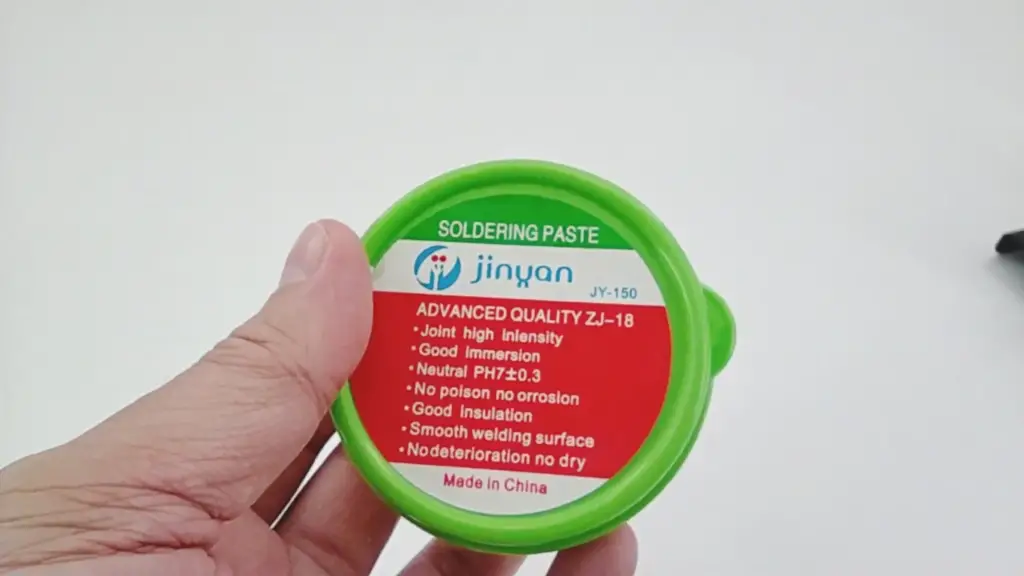
It is designed to dissolve oxides and other contaminants on the surfaces of the components being soldered, which helps create a better electrical connection. Flux is usually applied before the solder paste, but can also be used after if necessary.
What is Flux Made Out Of?
Flux typically contains a combination of acids, solvents and other materials. The most common flux is rosin-based flux, which contains rosin and alcohols.
Other types of fluxes include water soluble, acid core and no clean fluxes. Each type of flux has different properties and may be better suited for certain applications. [1]
What Other Factors Go Into Choosing a Flux?
When it comes to choosing the right flux, there are several factors to consider. It’s important to make sure that you choose a flux that is appropriate for the metals being soldered together, as some fluxes may cause corrosion or other damage.
Additionally, you should consider the type of application that you’re working on, as some fluxes may be better suited for certain tasks than others.

How Do You Use Flux?
Using flux is a fairly straightforward process.
- If you are using solder paste, apply the flux to the area where you wish to make the joint before the paste.
- Then, use a soldering iron to heat up the flux until it melts and begins to draw away contaminants from the surfaces being soldered.
- Once this is complete, apply solder paste and continue with your soldering process as normal.
- If you are using flux after applying solder paste, simply heat up the joint until the flux melts and helps create a stronger bond between components.
Why Do You Need Flux In Solder Pastes?
Flux is added to solder pastes for a few different reasons.
- First, it helps clean the surfaces of the components so that they make better contact with each other.
- Second, it helps reduce the melting point of the solder, making it easier to work with.
- Finally, flux helps prevent oxidation and corrosion on the soldered joint, which can affect the electrical connection.
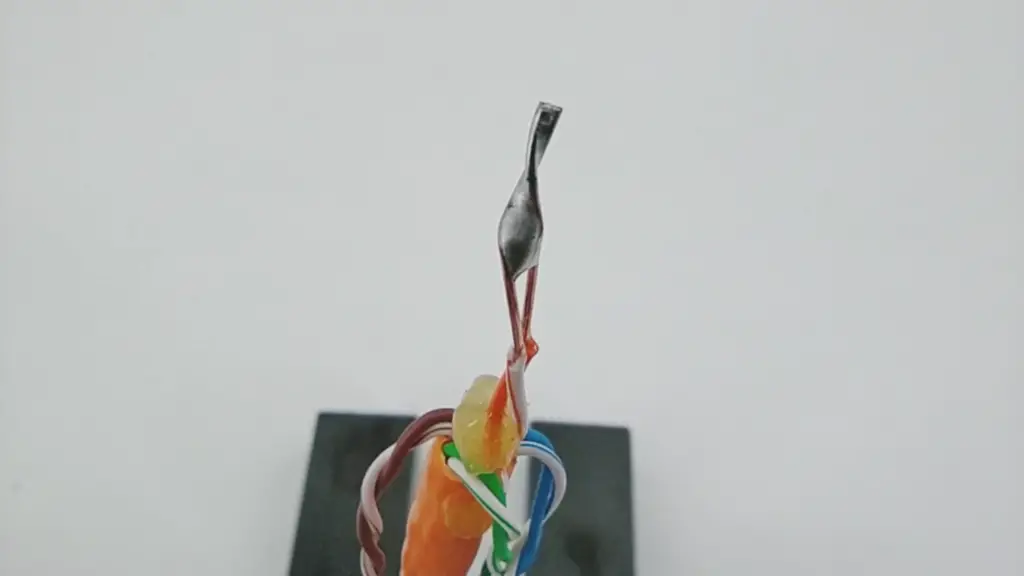
What Types of Solder Pastes With Flux Are Out There?
There are many different types of solder paste with flux. You can find water soluble and no-clean fluxed solder pastes in many different alloys and viscosities. It is important to review the product specifications before selecting one for your application.
Some solder paste may be designed specifically for certain applications, such as lead-free soldering or high temperature applications.
Can You Use Solder Paste Without Flux?
Yes, you can use solder paste without flux. However, the lack of flux may affect the strength and reliability of the connection. It is also possible that without flux, oxidation or corrosion could occur on the joint over time.
For this reason, it is usually recommended to use solder paste with flux for most applications.
How Do You Apply Solder Paste With Flux?
Applying solder paste with flux is generally the same as applying solder paste without.
- First, you will need to prepare the items that are being soldered by cleaning them with an appropriate solvent and making sure that all surfaces are dry.
- Then, using a syringe or other dispensing device, apply enough solder paste onto the area where you wish to make the joint.
- Next, use a soldering iron to heat the paste until it melts, creating a strong bond between two items.
- Finally, once the solder has cooled and hardened, gently wiggle or remove the components to ensure that the joint is secure.

FAQ
Is solder paste the same as flux?
No, solder paste and flux are two different products. Solder paste is a combination of metal alloy particles and a flux. The flux helps the solder melt easier and create a stronger bond between two items. Flux is a chemical cleaning agent that helps create a better electrical connection.
Do you need flux when soldering?
Yes, it is usually recommended to use flux when soldering. Flux helps clean the surfaces of the components and reduce the melting point of the solder, making it easier to work with. It also helps prevent oxidation and corrosion on the joint over time.
Can you use too much flux?
Yes, it is possible to use too much flux. Excessive flux can cause weak joints and increase the risk of solder bridging between two items. It is important to use just enough flux for your application.
Is flux needed with solder paste?
Yes, flux is usually needed with solder paste. The flux helps clean the surfaces of the components and reduce the melting point of the solder so that it can flow easily and make a strong electrical connection. Without flux, oxidation or corrosion could occur on the joint over time.
Is liquid flux better than paste?
It depends on the application. Both liquid flux and paste flux can be effective, but it may depend on the type of soldering you are doing and how much time you have available to work with.
In general, paste flux is easier to apply and quicker to work with than liquid flux. However, if you need a more aggressive cleaning action, liquid flux may be a better option.
Why is it better to use soldering paste flux when soldering?
Soldering paste flux helps the solder melt and makes it stick to the surfaces better. It also makes it so the surfaces don’t get rusty or dirty over time. Soldering paste flux can help make sure your electrical connection is good when you’re done soldering.
Can you use Vaseline instead of flux for soldering?
No, Vaseline is not a good substitute for flux when soldering. It does not have the same properties as flux, and it will not give you the same results. Instead of Vaseline, you should use a specially formulated flux that is designed for soldering applications.
What is the purpose of paste flux?
The purpose of paste flux is to help the solder stick to the surfaces better and make it easier to work with. It also helps keep the surfaces clean, which can help ensure a strong electrical connection. In addition, it reduces the melting point of the solder, making it easier to flow into tight spaces and around components.
Can I use Vaseline as flux?
No, Vaseline is not a suitable substitute for flux when soldering. You should always use an appropriate flux designed for soldering applications in order to get the best results. Vaseline does not have the same properties as a specially formulated solder paste flux and will not give you the same results.
How strong is solder paste?
Solder paste is strong enough to join two components together. The flux helps the solder to flow around the components and create a secure bond between them. Once the solder has cooled, check to make sure the joint is secure by gently wiggling or removing the components.
Are soldering flux and paste the same?
No, soldering flux and solder paste are not the same. Solder paste is a mixture of metal alloy particles and a flux. The purpose of the flux is to help the solder melt easier and create a stronger bond between two items.
Flux is a chemical cleaning agent that helps create a better electrical connection between the components. It also helps reduce the melting point of the solder, making it easier to work with.
Are flux and soldering paste necessary?
Yes, flux and soldering paste are necessary for most soldering applications. The flux is used to clean the surfaces of your components and prevent oxidation or corrosion over time. The solder paste helps to make sure the connection is strong and secure by reducing the melting point of the solder.
It is important to use just enough flux for your application. Too much flux can cause weak connections, while too little can result in poor electrical conductivity or corrosion over time. Always review product specifications before selecting a flux or solder paste for your application.
Can you use solder paste with a soldering iron?
Yes, you can use solder paste with a soldering iron. The key is to use the right amount of heat and flux for your application. In general, you should use lower temperatures when working with solder paste than with liquid flux.
Which solder paste is best?
The best solder paste for your application will depend on the type of components you are using and the environment in which it will be used. Generally, lead-free solder pastes are preferred for most applications because they create a stronger bond between components.
Some manufacturers specialise in high-performance fluxless soldiers that can be used with a variety of components. Be sure to read the product specifications and test one or more pastes before making a final decision.
Does solder paste work well?
Yes, solder paste can work very well if used correctly. Make sure to use the right amount of heat and flux for your application, as too much or too little can lead to weak connections or corrosion over time. Also, always read the product instructions and follow the manufacturer’s recommendations for best results.
What is the difference between Type 3 and Type 4 solder paste?
Type 3 solder paste is made from a blend of metal alloy particles and flux. It typically has lower melting temperatures than Type 4 solder paste, making it easier to work with in some applications.
Type 4 solder paste is often more expensive than Type 3, but it creates stronger connections between components. It can also be used at higher temperatures than Type 3, which is beneficial in some applications. Make sure to read the product specifications and test one or more pastes before making a final decision.
Do you need flux for solder paste?
Yes, you need flux for solder paste. The purpose of the flux is to help the solder melt easier and create a stronger bond between two items. Flux also helps reduce the melting point of the solder, making it easier to work with.
When working with solder paste, you should use just enough flux for your application. Too much flux can cause weak connections, while too little can result in poor electrical conductivity or corrosion over time.
Is liquid flux better than paste?
It depends on what you are making. Liquid flux is often easier to apply than solder paste, and it is also cheaper. But it can be difficult to get an even coat of liquid flux over a surface. If you are working with small components or in tight spaces, liquid flux may not be the best option.
What is the use of soldering paste flux?
Solder paste flux makes it easier to connect two components and helps reduce the melting point of solder. It also helps protect the metal surfaces from oxidation and corrosion. Make sure to read the product instructions and follow the manufacturer’s recommendations for your specific application.
Solder paste flux can be used with a variety of different soldering techniques, including hot-air and reflow soldering. Be sure to read the product specifications and test one or more pastes before making a final decision.
How long does paste flux last?
The shelf life of solder paste flux depends on the product you are using, but most have a shelf life between 12 and 24 months. To maximise shelf life, store unused paste flux in a sealed container at room temperature away from direct sunlight.
Should flux be refrigerated?
No, you should not refrigerate flux. If you refrigerate it, the paste will become too thick and difficult to work with. You should store unused solder paste at room temperature in a sealed container away from direct sunlight.
What happens if you don’t clean the flux?
If you don’t clean the flux off after soldering, it can corrode the metals and cause poor electrical connections. Over time, this can lead to costly repairs or even complete failure of your circuit boards.
It’s also important to use the right flux for your application. Depending on the project, you may need to use a more aggressive or milder flux. Be sure to read the product specifications and test one or more pastes before making a final decision.
Can you use too much flux when soldering?
Yes, you can use too much flux when soldering. Too much flux can cause weak connections and prevent solder from forming a strong bond between two items. Additionally, excessive flux residue on the surface can lead to corrosion over time.
Always read the product instructions and follow the manufacturer’s recommendations for your specific application. Be sure to use just enough flux for your application and clean off any excess residue with a lint-free cloth.
What you should not do after soldering?
After you solder something, you should never touch the area with your bare hands. The heat from the soldering iron can leave oils and residue on the surface that can cause corrosion or other problems down the road.
To clean the solder joint, do not blow on it. This will blow away the flux residue and cause a weak connection. Use a lint-free cloth to clean off any excess flux residue.
Useful Video: Soldering paste vs flux comparison
Conclusion
So, what’s the difference between flux and solder paste? In a nutshell, flux is used to clean the metal surface before soldering while solder paste is the actual material that will create the physical connection between two metals.
Flux helps remove oxidation from the surface of metal so that solder has a good surface to adhere to. Solder paste meanwhile contains both flux and solder in one go, making it an all-in-one solution for joining metals together.
When should you use flux vs solder paste? It really depends on your project – if you need a strong, permanent bond then solder paste is probably your best bet.
However, if you just need something to hold two pieces of metal together temporarily, flux will do the job without any fuss or mess. Thanks for reading!
References
- https://weldingmastermind.com/what-is-the-difference-between-solder-paste-and-flux/





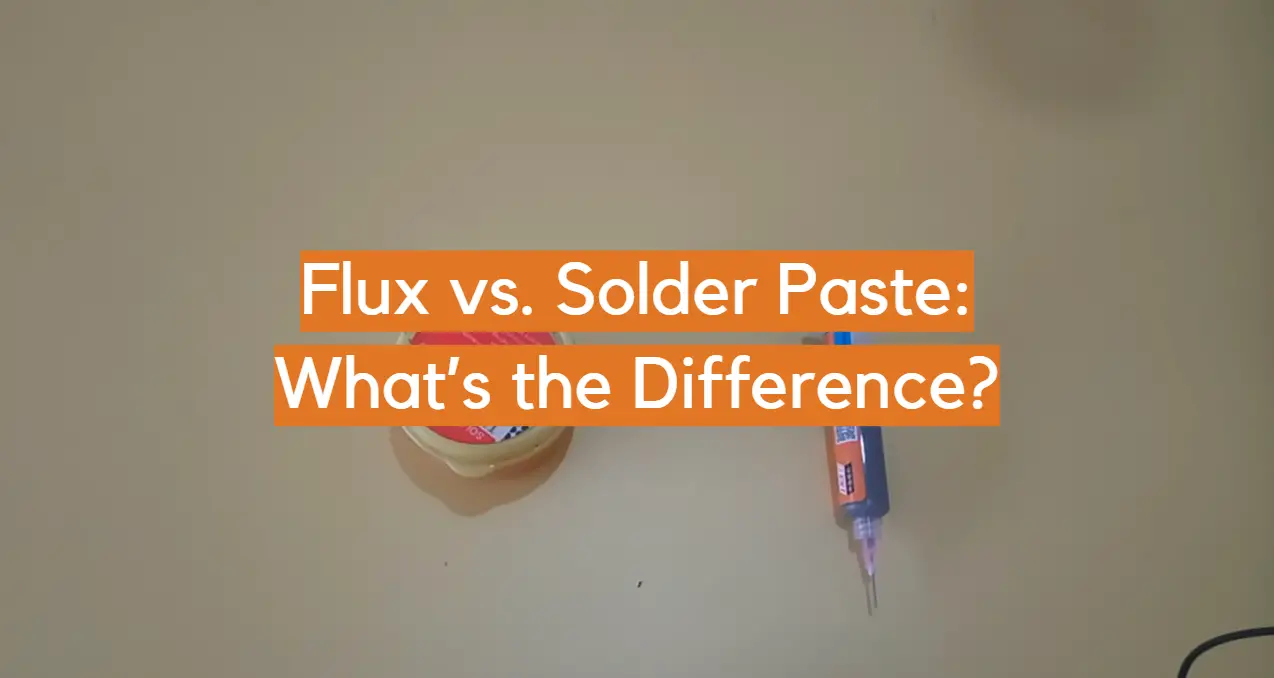



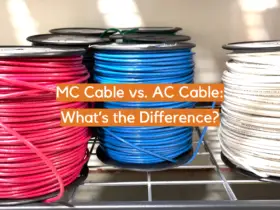



Leave a Reply